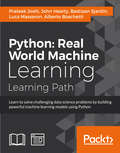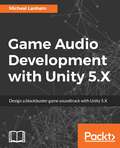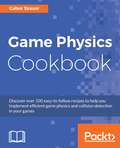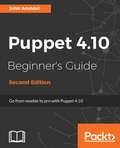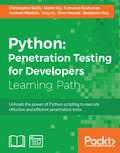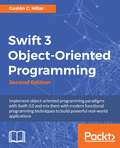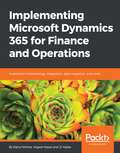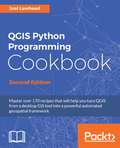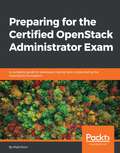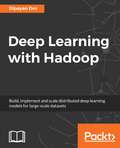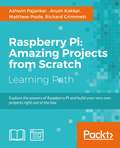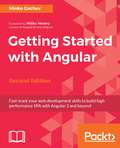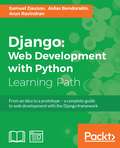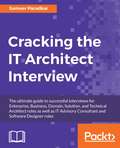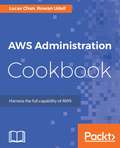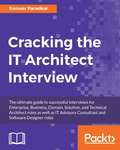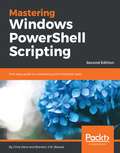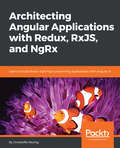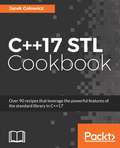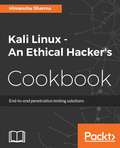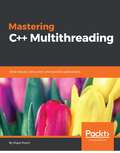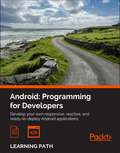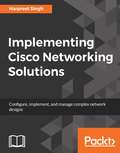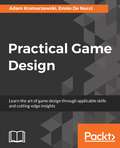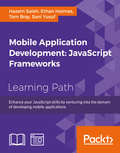- Table View
- List View
Python: Real World Machine Learning
by Prateek Joshi Luca Massaron John Hearty Bastiaan Sjardin Alberto BoschettiLearn to solve challenging data science problems by building powerful machine learning models using Python About This Book * Understand which algorithms to use in a given context with the help of this exciting recipe-based guide * This practical tutorial tackles real-world computing problems through a rigorous and effective approach * Build state-of-the-art models and develop personalized recommendations to perform machine learning at scale Who This Book Is For This Learning Path is for Python programmers who are looking to use machine learning algorithms to create real-world applications. It is ideal for Python professionals who want to work with large and complex datasets and Python developers and analysts or data scientists who are looking to add to their existing skills by accessing some of the most powerful recent trends in data science. Experience with Python, Jupyter Notebooks, and command-line execution together with a good level of mathematical knowledge to understand the concepts is expected. Machine learning basic knowledge is also expected. What You Will Learn * Use predictive modeling and apply it to real-world problems * Understand how to perform market segmentation using unsupervised learning * Apply your new-found skills to solve real problems, through clearly-explained code for every technique and test * Compete with top data scientists by gaining a practical and theoretical understanding of cutting-edge deep learning algorithms * Increase predictive accuracy with deep learning and scalable data-handling techniques * Work with modern state-of-the-art large-scale machine learning techniques * Learn to use Python code to implement a range of machine learning algorithms and techniques In Detail Machine learning is increasingly spreading in the modern data-driven world. It is used extensively across many fields such as search engines, robotics, self-driving cars, and more. Machine learning is transforming the way we understand and interact with the world around us. In the first module, Python Machine Learning Cookbook, you will learn how to perform various machine learning tasks using a wide variety of machine learning algorithms to solve real-world problems and use Python to implement these algorithms. The second module, Advanced Machine Learning with Python, is designed to take you on a guided tour of the most relevant and powerful machine learning techniques and you'll acquire a broad set of powerful skills in the area of feature selection and feature engineering. The third module in this learning path, Large Scale Machine Learning with Python, dives into scalable machine learning and the three forms of scalability. It covers the most effective machine learning techniques on a map reduce framework in Hadoop and Spark in Python. This Learning Path will teach you Python machine learning for the real world. The machine learning techniques covered in this Learning Path are at the forefront of commercial practice. This Learning Path combines some of the best that Packt has to offer in one complete, curated package. It includes content from the following Packt products: * Python Machine Learning Cookbook by Prateek Joshi * Advanced Machine Learning with Python by John Hearty * Large Scale Machine Learning with Python by Bastiaan Sjardin, Alberto Boschetti, Luca Massaron Style and approach This course is a smooth learning path that will teach you how to get started with Python machine learning for the real world, and develop solutions to real-world problems. Through this comprehensive course, you'll learn to create the most effective machine learning techniques from scratch and more!
Game Audio Development with Unity 5.X
by Micheal LanhamCreate �AAA' quality game audio with new features and tools built for Unity About This Book • Explore the basics of audio development in Unity to create spatial sound, mixing, effects, composition, adaptive audio and more. • Leverage the Audio Mixer of Unity 5.x to create blockbuster sound and music for your game. • Learn about developing professional audio for games with FMOD Studio and composing original music with Reaper. • Build amazing audio synchronized graphic visualizations with Unity. • Understand how real-time character lip syncing can be implemented. Who This Book Is For The ideal target audience for this book will be game developers, both Indie as well as semi pro. No prior knowledge of Unity and audio development is assumed, What You Will Learn • Develop game audio and other audio effects with Unity • Getting familiar with the new Audio Mixer introduced in Unity 5 • Implement dynamic and adaptive audio using various tools and strategies • Explore interesting ways to incorporate audio into a game with sound visualization • Use 3rd party professional audio development tools like FMOD • Compose original music and record vocals • Understand and troubleshoot audio performance issues In Detail Game Audio is one of the key components in making a game successful and it is quite popular in the gaming industry. So if you are a game developer with an eye on capturing the gamer market then this book is the right solution for you. In this book, we will take you through a step by step journey which will teach you to implement original and engaging soundtracks and SFX with Unity 5.x. You will be firstly introduced to the basics of game audio and sound development in Unity. After going through the core topics of audio development: audio sources, spatial sound, mixing, effects, and more; you will then have the option of delving deeper into more advanced topics like dynamic and adaptive audio. You will also learn to develop dynamic and adaptive audio using the Unity Audio Mixer. Further, you will learn how professional third party tools like FMOD are used for audio development in Unity. You will then go through the creation of sound visualization techniques and creating your own original music using the simple yet powerful audio workstation Reaper. Lastly, you will go through tips, techniques and strategies to help you optimize game audio performance or troubleshoot issues. At the end of the book, you'll have gained the skills to implement professional sound and music. Along with a good base knowledge audio and music principles you can apply across a range of other game development tools. Style and approach This book will have a step by step practical approach where downloadable free games will be given with the book and readers will be free to work with them.
Game Physics Cookbook
by Gabor SzauerDiscover over 100 easy-to-follow recipes to help you implement efficient game physics and collision detection in your games About This Book • Get a comprehensive coverage of techniques to create high performance collision detection in games • Learn the core mathematics concepts and physics involved in depicting collision detection for your games • Get a hands-on experience of building a rigid body physics engine Who This Book Is For This book is for beginner to intermediate game developers. You don't need to have a formal education in games—you can be a hobbyist or indie developer who started making games with Unity 3D. What You Will Learn • Implement fundamental maths so you can develop solid game physics • Use matrices to encode linear transformations • Know how to check geometric primitives for collisions • Build a Physics engine that can create realistic rigid body behavior • Understand advanced techniques, including the Separating Axis Theorem • Create physically accurate collision reactions • Explore spatial partitioning as an acceleration structure for collisions • Resolve rigid body collisions between primitive shapes In Detail Physics is really important for game programmers who want to add realism and functionality to their games. Collision detection in particular is a problem that affects all game developers, regardless of the platform, engine, or toolkit they use. This book will teach you the concepts and formulas behind collision detection. You will also be taught how to build a simple physics engine, where Rigid Body physics is the main focus, and learn about intersection algorithms for primitive shapes. You'll begin by building a strong foundation in mathematics that will be used throughout the book. We'll guide you through implementing 2D and 3D primitives and show you how to perform effective collision tests for them. We then pivot to one of the harder areas of game development—collision detection and resolution. Further on, you will learn what a Physics engine is, how to set up a game window, and how to implement rendering. We'll explore advanced physics topics such as constraint solving. You'll also find out how to implement a rudimentary physics engine, which you can use to build an Angry Birds type of game or a more advanced game. By the end of the book, you will have implemented all primitive and some advanced collision tests, and you will be able to read on geometry and linear Algebra formulas to take forward to your own games! Style and approach Gain the necessary skills needed to build a Physics engine for your games through practical recipes, in an easy-to-read manner. Every topic explained in the book has clear, easy to understand code accompanying it.
Puppet 4.10 Beginner's Guide - Second Edition
by John ArundelPuppet is great for developers, system administrators, IT professionals, and anyone laying the foundation for DevOps practices – this comprehensive guide will get you up to speed, all the way from installation to automation to the latest features of Puppet 4.10. About This Book • Develop skills to run Puppet 4.10 on single or multiple servers without hiccups • Use Puppet to spin up and manage cloud resources such as Amazon EC2 instances • Take full advantage of the powerful new features of Puppet 4.10, including loops, data types, structured facts, R10K module management, control repos, and EPP templates Who This Book Is For Puppet Beginner's Guide, Second Edition is designed for those who are new to Puppet, including system administrators and developers who are looking to manage computer server systems for configuration management. No prior programming or system administration experience is assumed. What You Will Learn • Covers the latest Puppet 4.10 release • Install and set up Puppet and discover the latest and most advanced features • Configure, build, and run containers in production using Puppet's industry-leading Docker support • Deploy configuration files and templates at super-fast speeds and manage user accounts and access control • Automate your IT infrastructure • Use the latest features in Puppet 4 onward and its official modules • Manage clouds, containers, and orchestration • Get to know the best practices to make Puppet more reliable and increase its performance In Detail Puppet 4.10 Beginner's Guide, Second Edition, gets you up and running with the very latest features of Puppet 4.10, including Docker containers, Hiera data, and Amazon AWS cloud orchestration. Go from beginner to confident Puppet user with a series of clear, practical examples to help you manage every aspect of your server setup. Whether you're a developer, a system administrator, or you are simply curious about Puppet, you'll learn Puppet skills that you can put into practice right away. With practical steps giving you the key concepts you need, this book teaches you how to install packages and config files, create users, set up scheduled jobs, provision cloud instances, build containers, and so much more. Every example in this book deals with something real and practical that you're likely to need in your work, and you'll see the complete Puppet code that makes it happen, along with step-by-step instructions for what to type and what output you'll see. All the examples are available in a GitHub repo for you to download and adapt for your own server setup. Style and approach This tutorial is packed with quick step-by-step instructions that are immediately applicable for beginners. This is an easy-to-read guide, to learn Puppet from scratch, that explains simply and clearly all you need to know to use this essential IT power tool, while applying these solutions to real-world scenarios.
Python: Penetration Testing for Developers
by Mohit Terry Ip Andrew Mabbitt Cameron Buchanan Dave Mound Benjamin May Christopher DuffyUnleash the power of Python scripting to execute effective and efficient penetration tests About This Book * Sharpen your pentesting skills with Python * Develop your fluency with Python to write sharper scripts for rigorous security testing * Get stuck into some of the most powerful tools in the security world Who This Book Is For If you are a Python programmer or a security researcher who has basic knowledge of Python programming and wants to learn about penetration testing with the help of Python, this course is ideal for you. Even if you are new to the field of ethical hacking, this course can help you find the vulnerabilities in your system so that you are ready to tackle any kind of attack or intrusion. What You Will Learn * Familiarize yourself with the generation of Metasploit resource files and use the Metasploit Remote Procedure Call to automate exploit generation and execution * Exploit the Remote File Inclusion to gain administrative access to systems with Python and other scripting languages * Crack an organization's Internet perimeter and chain exploits to gain deeper access to an organization's resources * Explore wireless traffic with the help of various programs and perform wireless attacks with Python programs * Gather passive information from a website using automated scripts and perform XSS, SQL injection, and parameter tampering attacks * Develop complicated header-based attacks through Python In Detail Cybercriminals are always one step ahead, when it comes to tools and techniques. This means you need to use the same tools and adopt the same mindset to properly secure your software. This course shows you how to do just that, demonstrating how effective Python can be for powerful pentesting that keeps your software safe. Comprising of three key modules, follow each one to push your Python and security skills to the next level. In the first module, we'll show you how to get to grips with the fundamentals. This means you'll quickly find out how to tackle some of the common challenges facing pentesters using custom Python tools designed specifically for your needs. You'll also learn what tools to use and when, giving you complete confidence when deploying your pentester tools to combat any potential threat. In the next module you'll begin hacking into the application layer. Covering everything from parameter tampering, DDoS, XXS and SQL injection, it will build on the knowledge and skills you learned in the first module to make you an even more fluent security expert. Finally in the third module, you'll find more than 60 Python pentesting recipes. We think this will soon become your trusted resource for any pentesting situation. This Learning Path combines some of the best that Packt has to offer in one complete, curated package. It includes content from the following Packt products: * Learning Penetration Testing with Python by Christopher Duffy * Python Penetration Testing Essentials by Mohit * Python Web Penetration Testing Cookbook by Cameron Buchanan,Terry Ip, Andrew Mabbitt, Benjamin May and Dave Mound Style and approach This course provides a quick access to powerful, modern tools, and customizable scripts to kick-start the creation of your own Python web penetration testing toolbox.
Swift 3 Object Oriented Programming - Second Edition
by Gaston C. HillarThis book is for iOS and macOS developers who want to get a detailed practical understanding of object-oriented programming with the latest version of Swift: 3.0.
Implementing Microsoft Dynamics 365 for Finance and Operations
by Rahul Mohta Yogesh Kasat Jj YadavHarness the power of Dynamics 365 Operations and discover all you need to implement it About This Book • Master all the necessary tools and resources to evaluate Dynamics 365 for Operations, implement it, and proactively maintain it. • Troubleshoot your problems effectively with your Dynamics 365 partner • Learn about architecture, deployment choices, integration, configuration and data migration, development, testing, reporting and BI, support, upgrading, and more. Who This Book Is For This book is for technology leaders, project managers solution architects, and consultants who are planning to implement, are in the process of implementing, or are currently upgrading to Dynamics 365 for Operations. This book will help you effectively learn and implement Dynamics 365 for Operations. What You Will Learn • Learn about Microsoft Dynamics 365, it's offerings, plans and details of Finance and Operations, Enterprise edition • Understand the methodology and the tool, architecture, and deployment options • Effectively plan and manage configurations and data migration, functional design, and technical design • Understand integration frameworks, development concepts, best practices, and recommendations while developing new solutions • Learn how to leverage intelligence and analytics through Power BI, machine learning, IOT, and Cortana intelligence • Master testing, training, going live, upgrading, and how to get support during and after the implementation In Detail Microsoft Dynamics 365 for Finance and Operations, Enterprise edition, is a modern, cloud-first, mobile-first, ERP solution suitable for medium and large enterprise customers. This book will guide you through the entire life cycle of a implementation, helping you avoid common pitfalls while increasing your efficiency and effectiveness at every stage of the project. Starting with the foundations, the book introduces the Microsoft Dynamics 365 offerings, plans, and products. You will be taken through the various methodologies, architectures, and deployments so you can select, implement, and maintain Microsoft Dynamics 365 for Finance and Operations, Enterprise edition. You will delve in-depth into the various phases of implementation: project management, analysis, configuration, data migration, design, development, using Power BI, machine learning, Cortana analytics for intelligence, testing, training, and finally deployment, support cycles, and upgrading. This book focuses on providing you with information about the product and the various concepts and tools, along with real-life examples from the field and guidance that will empower you to execute and implement Dynamics 365 for Finance and Operations, Enterprise edition. Style and approach This book is a step-by-step guide focusing on implementing Dynamics 365 Operations solutions for your organization.
QGIS Python Programming Cookbook - Second Edition
by Joel LawheadMaster over 170 recipes that will help you turn QGIS from a desktop GIS tool into a powerful automated geospatial framework About This Book • Delve into the undocumented features of the QGIS API • Get a set of user-friendly recipes that can automate entire geospatial workflows by connecting Python GIS building blocks into comprehensive processes • This book has a complete code upgrade to QGIS 2.18 and 30 new, valuable recipes Who This Book Is For This book is for geospatial analysts who want to learn more about automating everyday GIS tasks as well as programmers responsible for building GIS applications. The short, reusable recipes make concepts easy to understand and combine so you can build larger applications that are easy to maintain. What You Will Learn • Use Python and QGIS to produce captivating GIS visualizations and build complex map layouts • Find out how to effectively use the poorly-documented and undocumented features of the QGIS Python API • Automate entire geospatial workflows by connecting Python GIS building blocks into comprehensive processes • Create, import, and edit geospatial data on disk or in-memory • Change QGIS settings programmatically to control default behavior • Automatically generate PDF map books • Build dynamic forms for field input In Detail QGIS is a desktop geographic information system that facilitates data viewing, editing, and analysis. Paired with the most efficient scripting language—Python, we can write effective scripts that extend the core functionality of QGIS. Based on version QGIS 2.18, this book will teach you how to write Python code that works with spatial data to automate geoprocessing tasks in QGIS. It will cover topics such as querying and editing vector data and using raster data. You will also learn to create, edit, and optimize a vector layer for faster queries, reproject a vector layer, reduce the number of vertices in a vector layer without losing critical data, and convert a raster to a vector. Following this, you will work through recipes that will help you compose static maps, create heavily customized maps, and add specialized labels and annotations. As well as this, we'll also share a few tips and tricks based on different aspects of QGIS. Style and approach This book follows a recipe-based problem-solution approach to address and dispel challenges faced when implementing and using QGIS on a regular basis.
Preparing for the Certified OpenStack Administrator Exam
by Matt DornMaster the objectives required to pass the Certified OpenStack Administrator exam. About This Book • Focuses on providing a clear, concise strategy so you gain the specific skills required to pass the Certified OpenStack Administrator exam • Includes exercises and performance-based tasks to ensure all exam objectives can be completed via the Horizon dashboard and command-line interface • Includes a free OpenStack Virtual Appliance to practice the objectives covered throughout the book • Includes a practice exam to put your OpenStack skills to the test to prove you have what it takes to conquer the live exam • Updated for the 2017 exam featuring OpenStack Newton Who This Book Is For This book is for IT professionals, system administrators, DevOps engineers, and software developers with basic Linux command-line and networking knowledge. It's also a great guide for those interested in an entry-level OpenStack position but have limited real-world OpenStack experience. After passing the exam, Certified OpenStack Administrators will prove they have the required skills for the job. What You Will Learn • Manage the Keystone identity service by creating and modifying domains, groups, projects, users, roles, services, endpoints, and quotas. • Upload Glance images, launch new Nova instances, and create flavors, key pairs, and snapshots. • Discover Neutron tenant and provider networks, security groups, routers, and floating IPs. • Manage the Cinder block storage service by creating volumes and attaching them to instances. • Create Swift containers and set access control lists to allow read/write access to your objects. • Explore Heat orchestration templates and create, list, and update stacks. In Detail This book provides you with a specific strategy to pass the OpenStack Foundation's first professional certification: the Certified OpenStack Administrator. In a recent survey, 78% of respondents said the OpenStack skills shortage had deterred them from adopting OpenStack. Consider this an opportunity to increase employer and customer confidence by proving you have the skills required to administrate real-world OpenStack clouds. You will begin your journey by getting well-versed with the OpenStack environment, understanding the benefits of taking the exam, and installing an included OpenStack all-in-one virtual appliance so you can work through objectives covered throughout the book. After exploring the basics of the individual services, you will be introduced to strategies to accomplish the exam objectives relevant to Keystone, Glance, Nova, Neutron, Cinder, Swift, Heat, and troubleshooting. Finally, you'll benefit from the special tips section and a practice exam to put your knowledge to the test. By the end of the journey, you will be ready to become a Certified OpenStack Administrator! Style and approach Clear, concise, and straightforward with supporting diagrams and lab environment tutorials, this book will help you confidently pass Certified OpenStack Administrator objectives on the Horizon dashboard and command-line interface.
Deep Learning with Hadoop
by Dipayan DevIf you are a data scientist who wants to learn how to perform deep learning on Hadoop, this is the book for you. Knowledge of the basic machine learning concepts and some understanding of Hadoop is required to make the best use of this book.
Raspberry Pi: Making Amazing Projects Right from Scratch!
by Ashwin Pajankar Richard Grimmett Arush Kakkar Matthew PooleExplore the powers of Raspberry Pi and build your very own projects right out of the box About This Book * From robotics to gaming, this Learning Path will unlock your creativity! * Build your own impressive IoT projects to transform your home * Featuring some of Packt's very best Raspberry Pi content, this Learning Path doesn't just get you to your destination - it opens up a whole horizon of possibilities! Who This Book Is For Want new ideas for your next Raspberry Pi project? Got one lying around gathering dust? This Learning Path gets you straight into the creative dirty work of programming and playing with your pi. Whether your new to Raspberry Pi, or an experienced maker, we think this Learning Path will inspire you and get your creative juices flowing! What You Will Learn * Discover an aweome range of Raspberry Pi projects * Bridge the gap between software and hardware through your Pi and find out how to make an operating system interact with cameras and other hardware * Find out how to use your Raspberry Pi for gaming * Secure your home with this tiny computer! * Make science fiction a reality - build a walking robot In Detail Looking for inspiration for your next Raspberry Pi project? Not sure where to begin? This Learning Path is the perfect place to begin, providing you with an accessible yet comprehensive journey through Raspberry Pi. Following three modules, you'll soon be confident and prepared to get creative with your microcomputer. Raspberry Pi by Example is the first module in this Learning Path - and it does exactly what it says. It doesn't just teach, it shows you how to go and build some awesome Raspberry Pi projects immediately. Build and play your own games with the Pi, build a complete Internet of Things home automation system that controls your house through Twitter... let your imagination run wild! In the next module we'll look in more depth at building a home security system. You'll be using some of the skills you devoped through the first module, but apply them to something more intricate and impressive. Using a Linux based operating system as the foundations, you'll gradually build up an entire security infrastructure adding cameras, remote controls, and even intrusion alerts! In the final module, we'll take you into the world of Raspberry Pi robotics. By the end of it, you'll have built a biped robot that can interact with its environment! This Learning Path combines some of the best that Packt has to offer in one complete, curated package. It includes content from the following Packt products: * Raspberry Pi By Example by Ashwin Pajankar and Arush Kakkar * Building a Home Security System with Raspberry Pi by Matthew Pole * Raspberry Pi Robotics Essentials by Richard Grimmett Style and approach It's not every day you build a home automation system. It's not every day you build a walking robot. But with this Learning Path you'll do just that. So get started and let this tiny computer expand your imagination.
Getting Started with Angular - Second Edition
by Minko GechevFast-track your web development skills to build high performance SPA with Angular 2 and beyond About This Book • Up to date with the latest API changes introduced by Angular 2 and 4 • Get familiar with the improvements to directives, change detection, dependency injection, router, and more • Understand Angular's new component-based architecture • Start using TypeScript to supercharge your Angular applications Who This Book Is For Do you want to jump in at the deep end of Angular? Or perhaps you're interested assessing the changes to AngularJS before moving over? If so, then "Getting Started with Angular" is the book for you. To get the most out of the book, you'll need to be familiar with AngularJS 1.x, and have a good understanding of JavaScript. What You Will Learn • Understand the changes made from AngularJS with side-by-side code samples to help demystify the Angular learning curve • Start working with Angular's new method of implementing directives • Use TypeScript to write modern, powerful Angular applications • Dig in to the change detection method, and other architectural changes to make sure you know what's going on under the hood of Angular • Get to work with the new router in Angular • Use the new features of Angular, including pipes, and the updated features such as forms, services, and dependency injection • Learn about the server-side rendering in Angular to keep your new applications SEO-friendly • Enhance your applications using Ahead-of-Time compilation and Web Workers In Detail I'm delighted to see this new update and hope it helps you build amazing things with Angular. - Misko Hevery, Creator of AngularJS and Angular Angular is the modern framework you need to build performant and robust web applications. This book is the quickest way to upgrade your AngularJS knowledge to the brave new world of Angular, and get grips with the framework. It starts with an overview putting the changes of the framework in context with version 1. After that, you will be taken on a TypeScript crash-course so you can take advantage of Angular in its native, statically-typed environment. You'll explore the new change detection mechanism in detail, how directives and components have changed, how you create applications with Angular, and much more. Next, you'll understand how to efficienly develop forms, use the router, implement communication with HTTP services, and transform data with custom pipes. Finally, we will take a look at the Angular's Ahead-of-Time compiler, angular-cli and other such tools that help us build professional applications. By the end of the book, you'll be ready to start building quick and efficient Angular applications compatible with v2 and v4, that take advantage of all the new features on offer. This book is up to date for the 2.4 release and is compatible with the 4.0 release as well. Style and approach Starting with a comparison between Angular versions, this book is filled with side-by-side code examples to help highlight the changes. Each chapter then looks at major changes to the framework and is filled with small examples and sample code to get you started.
Django: Web Development with Python
by Samuel Dauzon Aidas Bendoraitis Arun Ravindran<P><P>About This Book <P><P>Explore the best practices to develop applications of a superior quality with Django framework <P><P>Unravel the common problems of web development in Django <P><P>This course teaches you major Django functions and will help you improve your skills by developing models, forms, views, and templates <P><P>Experience the challenges of working on an end-to-end social network project <P><P>Who This Book Is For <P><P>Web developers who want to use modern Python-based web frameworks like Django to build powerful web applications. The course is mostly self-contained and introduces web development with Python to a reader who is familiar with web development concepts and can help him become an expert in this trade. It's intended for all levels of web developers, both students and practitioners from novice to experts. <P><P>What You Will Learn <P><P>Use Django models to store information in a database and generate queries to access a database across models <P><P>Quickly develop web pages to create, read, update, and delete data from the model using class-based views <P><P>Generate very maintainable forms with Django <P><P>Import data from local sources and external web services, as well as exporting your data to third parties <P><P>Deep dive into various aspects of Django, from models and views to testing and deployment <P><P>Familiarize yourself with the various nuances of web development such as browser attacks and databases <P><P>In Detail <P><P>Data science is hot right now, and the need for multitalented developers is greater than ever before. A basic grounding in building apps with a framework as minimalistic, powerful, and easy-to-learn as Django will be a useful skill when launching your career as an entrepreneur or web developer. <P><P>Django is a web framework that was designed to strike a balance between rapid web development and high performance. This course will take you on a journey to become an efficient web developer who thoroughly understands the key concepts of the Django framework. <P><P>The first module, Django Essentials, is a practical guide, filled with many real-world examples to build highly effective Django web applications. In the second module, Web Development with Django Cookbook, you'll learn varying complexities to help you create multilingual, responsive, and scalable websites with Django. The next step is to discover the latest best practices and idioms in the rapidly evolving Django framework. This is what you'll be learning in our third module, Django Design Patterns and Best Practices. By the end of the module, you will be able to leverage the Django framework to develop a fully functional web application with minimal effort.
Cracking the IT Architect Interview
by Sameer ParadkarThe ultimate guide to successful interviews for Enterprise, Business, Domain, Solution, and Technical Architect roles as well as IT Advisory Consultant and Software Designer roles About This Book * Learn about Enterprise Architects IT strategy and NFR - this book provides you with methodologies, best practices, and frameworks to ace your interview * A holistic view of key architectural skills and competencies with 500+ questions that cover 12 domains * 100+ diagrams depicting scenarios, models, and methodologies designed to help you prepare for your interview Who This Book Is For This book is for aspiring enterprise, business, domain, solution, and technical architects. It is also ideal for IT advisory consultants and IT designers who wish to interview for such a role. Interviewers will be able leverage this book to make sure they hire candidates with the right competencies to meet the role requirements. What You Will Learn * Learn about IT strategies, NFR, methodologies, best practices, and frameworks to ace your interview * Get a holistic view of key concepts, design principles, and patterns related to evangelizing web and Java enterprise applications * Discover interview preparation guidelines through case studies * Use this as a reference guide for adopting best practices, standards, and design guidelines * Get a better understanding with 60+ diagrams depicting various scenarios, models, and methodologies * Benefit from coverage of all architecture domains including EA (Business, Data, Infrastructure, and Application), SA, integration, NFRs, security, and SOA, with extended coverage from IT strategies to the NFR domain In Detail An architect attends multiple interviews for jobs or projects during the course of his or her career. This book is an interview resource created for designers, consultants, technical, solution, domain, enterprise, and chief architects to help them perform well in interview discussions and launch a successful career. The book begins by providing descriptions of architecture skills and competencies that cover the 12 key domains, including 350+ questions relating to these domains. The goal of this book is to cover all the core architectural domains. From an architect's perspective, it is impossible to revise or learn about all these key areas without a good reference guide - this book is the solution. It shares experiences, learning, insights, and proven methodologies that will benefit practitioners, SMEs, and aspirants in the long run. This book will help you tackle the NFR domain, which is a key aspect pertaining to architecting applications. It typically takes years to understand the core concepts, fundamentals, patterns, and principles related to architecture and designs. This book is a goldmine for the typical questions asked during an interview and will help prepare you for success! Style and approach This book will help you prepare for interviews for architectural profiles by providing likely questions, explanations, and expected answers. It is an insight-rich guide that will help you develop strategic, tactical, and operational thinking for your interview.
AWS Administration Cookbook
by Lucas Chan Rowan UdellBuild, automate, and manage your AWS-based cloud environments About This Book • Install, configure, and administer computing, storage, and networking in the AWS cloud • Automate your infrastructure and control every aspect of it through infrastructure as code • Work through exciting recipes to administer your AWS cloud Who This Book Is For If you are an administrator, DevOps engineer, or an IT professional who is moving to an AWS-based cloud environment, then this book is for you. It assumes familiarity with cloud computing platforms, and that you have some understanding of virtualization, networking, and other administration-related tasks. What You Will Learn • Discover the best practices to achieve an automated repeatable infrastructure in AWS • Bring down your IT costs by managing AWS successfully and deliver high availability, fault tolerance, and scalability • Make any website faster with static and dynamic caching • Create monitoring and alerting dashboards using CloudWatch • Migrate a database to AWS • Set up consolidated billing to achieve simple and effective cost management with accounts • Host a domain and find out how you can automate health checks In Detail Amazon Web Services (AWS) is a bundled remote computing service that provides cloud computing infrastructure over the Internet with storage, bandwidth, and customized support for application programming interfaces (API). Implementing these services to efficiently administer your cloud environments is a core task. This book will help you build and administer your cloud environment with AWS. We'll begin with the AWS fundamentals, and you'll build the foundation for the recipes you'll work on throughout the book. Next, you will find out how to manage multiple accounts and set up consolidated billing. You will then learn to set up reliable and fast hosting for static websites, share data between running instances, and back up your data for compliance. Moving on, you will find out how to use the compute service to enable consistent and fast instance provisioning, and will see how to provision storage volumes and autoscale an application server. Next, you'll discover how to effectively use the networking and database service of AWS. You will also learn about the different management tools of AWS along with securing your AWS cloud. Finally, you will learn to estimate the costs for your cloud. By the end of the book, you will be able to easily administer your AWS cloud. Style and approach This practical guide is packed with clear, practical, instruction-based recipes that will enable you to use and implement the latest features of AWS.
Cracking the IT Architect Interview
by Sameer Paradkar<P><P>Key Features <P><P>Learn about Enterprise Architects IT strategy and NFR – this book provides you with methodologies, best practices, and frameworks to ace your interview <P><P>A holistic view of key architectural skills and competencies with 500+ questions that cover 12 domains <P><P>100+ diagrams depicting scenarios, models, and methodologies designed to help you prepare for your interview <P><P>Book Description <P><P>An architect attends multiple interviews for jobs or projects during the course of his or her career. This book is an interview resource created for designers, consultants, technical, solution, domain, enterprise, and chief architects to help them perform well in interview discussions and launch a successful career. <P><P>The book begins by providing descriptions of architecture skills and competencies that cover the 12 key domains, including 350+ questions relating to these domains. The goal of this book is to cover all the core architectural domains. From an architect’s perspective, it is impossible to revise or learn about all these key areas without a good reference guide – this book is the solution. It shares experiences, learning, insights, and proven methodologies that will benefit practitioners, SMEs, and aspirants in the long run. <P><P>This book will help you tackle the NFR domain, which is a key aspect pertaining to architecting applications. <P><P>It typically takes years to understand the core concepts, fundamentals, patterns, and principles related to architecture and designs. This book is a goldmine for the typical questions asked during an interview and will help prepare you for success! <P><P>What you will learn <P><P>Learn about IT strategies, NFR, methodologies, best practices, and frameworks to ace your interview <P><P>Get a holistic view of key concepts, design principles, and patterns related to evangelizing web and Java enterprise applications <P><P>Discover interview preparation guidelines through case studies <P><P>Use this as a reference guide for adopting best practices, standards, and design guidelines <P><P>Get a better understanding with 60+ diagrams depicting various scenarios, models, and methodologies <P><P>Benefit from coverage of all architecture domains including EA (Business, Data, Infrastructure, and Application), SA, integration, NFRs, security, and SOA, with extended coverage from IT strategies to the NFR domain
Mastering Windows PowerShell Scripting - Second Edition
by Chris Dent Brenton J.W. BlawatMaster the art of automating and managing your environment using PowerShell About This Book • Find quick solutions to automate your environment with ease • Work with large amounts of data effortlessly with PowerShell data types and secure them • Packed with real-world examples to automate and simplify the management of your Windows environment Who This Book Is For If you are a system administrator who wants to become an expert in controlling and automating your Windows environment, then this book is for you. It is also for those new to the PowerShell language. What You Will Learn • Optimize code through the use of functions, switches, and looping structures • Install PowerShell on your Linux system • Utilize variables, hashes, and arrays to store data • Work with Objects and Operators to test and manipulate data • Parse and manipulate different data types • Write .NET classes with ease within the PowerShell • Create and implement regular expressions in PowerShell scripts • Deploy applications and code with PowerShell's Package management modules • Leverage session-based remote management • Manage files, folders, and registries through the use of PowerShell In Detail PowerShell scripts offer a handy way to automate various chores. Working with these scripts effectively can be a difficult task. This comprehensive guide starts from scratch and covers advanced-level topics to make you a PowerShell expert. The first module, PowerShell Fundamentals, begins with new features, installing PowerShell on Linux, working with parameters and objects, and also how you can work with .NET classes from within PowerShell. In the next module, you'll see how to efficiently manage large amounts of data and interact with other services using PowerShell. You'll be able to make the most of PowerShell's powerful automation feature, where you will have different methods to parse and manipulate data, regular expressions, and WMI. After automation, you will enter the Extending PowerShell module, which covers topics such as asynchronous processing and, creating modules. The final step is to secure your PowerShell, so you will land in the last module, Securing and Debugging PowerShell, which covers PowerShell execution policies, error handling techniques, and testing. By the end of the book, you will be an expert in using the PowerShell language. Style and approach This practical guide covers all the advanced PowerShell functionalities that an administrator needs to learn to automate their environments.
Architecting Angular Applications with Redux, RxJS, and NgRx: Learn to build Redux style high-performing applications with Angular 6
by Christoffer NoringManage state in Angular to write high performing web apps by combining the power of Flux, RxJS, and NgRxKey Features- Learn what makes an excellent Angular application architecture- Use Redux to write performant, consistent Angular applications- Incorporate Reactive Programming principles and RxJS to make it easier to develop, test, and debug your Angular applicationsBook DescriptionManaging the state of large-scale web applications is a highly challenging task with the need to align different components, backends, and web workers harmoniously. When it comes to Angular, you can use NgRx, which combines the simplicity of Redux with the reactive programming power of RxJS to build your application architecture, making your code elegant and easy to reason about, debug, and test.In this book, we start by looking at the different ways of architecting Angular applications and some of the patterns that are involved in it. This will be followed by a discussion on one-way data flow, the Flux pattern, and the origin of Redux.The book introduces you to declarative programming or, more precisely, functional programming and talks about its advantages. We then move on to the reactive programming paradigm. Reactive programming is a concept heavily used in Angular and is at the core of NgRx. Later, we look at RxJS, as a library and master it. We thoroughly describe how Redux works and how to implement it from scratch. The two last chapters of the book cover everything NgRx has to offer in terms of core functionality and supporting libraries, including how to build a micro implementation of NgRx.This book will empower you to not only use Redux and NgRx to the fullest, but also feel confident in building your own version, should you need it.What you will learnUnderstand the one-way data flow and Flux patternWork with functional programming and asynchronous data streamsFigure out how RxJS can help us address the flaws in promisesSet up different versions of cascading callsExplore advanced operatorsGet familiar with the Redux pattern and its principlesTest and debug different features of your applicationBuild your own lightweight app using Flux, Redux, and NgRxWho this book is forIf you have been developing Angular applications and want to dive deeper into the Angular architecture with Redux, RxJS, and NgRx to write robust web apps, then this book is for you.
C++17 STL Cookbook
by Jacek GalowiczOver 90 recipes that leverage the powerful features of the Standard Library in C++17 About This Book • Learn the latest features of C++ and how to write better code by using the Standard Library (STL). Reduce the development time for your applications. • Understand the scope and power of STL features to deal with real-world problems. • Compose your own algorithms without forfeiting the simplicity and elegance of the STL way. Who This Book Is For This book is for intermediate-to-advanced C++ programmers who want to get the most out of the Standard Template Library of the newest version of C++: C++ 17. What You Will Learn • Learn about the new core language features and the problems they were intended to solve • Understand the inner workings and requirements of iterators by implementing them • Explore algorithms, functional programming style, and lambda expressions • Leverage the rich, portable, fast, and well-tested set of well-designed algorithms provided in the STL • Work with strings the STL way instead of handcrafting C-style code • Understand standard support classes for concurrency and synchronization, and how to put them to work • Use the filesystem library addition available with the C++17 STL In Detail C++ has come a long way and is in use in every area of the industry. Fast, efficient, and flexible, it is used to solve many problems. The upcoming version of C++ will see programmers change the way they code. If you want to grasp the practical usefulness of the C++17 STL in order to write smarter, fully portable code, then this book is for you. Beginning with new language features, this book will help you understand the language's mechanics and library features, and offers insight into how they work. Unlike other books, ours takes an implementation-specific, problem-solution approach that will help you quickly overcome hurdles. You will learn the core STL concepts, such as containers, algorithms, utility classes, lambda expressions, iterators, and more, while working on practical real-world recipes. These recipes will help you get the most from the STL and show you how to program in a better way. By the end of the book, you will be up to date with the latest C++17 features and save time and effort while solving tasks elegantly using the STL. Style and approach This recipe-based guide will show you how to make the best use of C++ together with the STL to squeeze more out of the standard language
Kali Linux - An Ethical Hacker's Cookbook
by Himanshu SharmaWith the current rate of hacking, it is very important to pentest your environment in order to ensure advanced-level security. This book will be packed with practical recipes that will quickly get you started with Kali Linux (version 2016.2) as per your requirements and move on to core functionalities.
Mastering C++ Multithreading
by Maya PoschMaster multithreading and concurrent processing with C++ About This Book • Delve into the fundamentals of multithreading and concurrency and find out how to implement them • Explore atomic operations to optimize code performance • Apply concurrency to both distributed computing and GPGPU processing Who This Book Is For This book is for intermediate C++ developers who wish to extend their knowledge of multithreading and concurrent processing. You should have basic experience with multithreading and be comfortable using C++ development toolchains on the command line. What You Will Learn • Deep dive into the details of the how various operating systems currently implement multithreading • Choose the best multithreading APIs when designing a new application • Explore the use of mutexes, spin-locks, and other synchronization concepts and see how to safely pass data between threads • Understand the level of API support provided by various C++ toolchains • Resolve common issues in multithreaded code and recognize common pitfalls using tools such as Memcheck, CacheGrind, DRD, Helgrind, and more • Discover the nature of atomic operations and understand how they can be useful in optimizing code • Implement a multithreaded application in a distributed computing environment • Design a C++-based GPGPU application that employs multithreading In Detail Multithreaded applications execute multiple threads in a single processor environment, allowing developers achieve concurrency. This book will teach you the finer points of multithreading and concurrency concepts and how to apply them efficiently in C++. Divided into three modules, we start with a brief introduction to the fundamentals of multithreading and concurrency concepts. We then take an in-depth look at how these concepts work at the hardware-level as well as how both operating systems and frameworks use these low-level functions. In the next module, you will learn about the native multithreading and concurrency support available in C++ since the 2011 revision, synchronization and communication between threads, debugging concurrent C++ applications, and the best programming practices in C++. In the final module, you will learn about atomic operations before moving on to apply concurrency to distributed and GPGPU-based processing. The comprehensive coverage of essential multithreading concepts means you will be able to efficiently apply multithreading concepts while coding in C++. Style and approach This book is filled with examples that will help you become a master at writing robust concurrent and parallel applications in C++.
Android: Programming for Developers
by Helder Vasconcelos Raul Portales John HortonDevelop your own responsive, reactive, and ready-to-deploy Android applications About This Book * Kick-start your Android programming career or just have fun publishing apps to the Google Play marketplace * Explore the high-level Android asynchronous constructs available on the Android SDK * Learn the internals of a game engine by building one Who This Book Is For If you are an iOS developer or any other developer/programmer and you want to try your hands on developing applications on the Android platform, this course is for you. No prior programming experience is needed as this course will guide you right from the beginning to the advanced concepts of Android programming. What You Will Learn * Mastering the fundamentals of coding Java for Android * Installing and setting up your Android development environment * Building functional user interfaces with the Android Studio visual designer * Adding user interaction, data captures, sound, and animation to your apps * Managing your apps' data using the built-in Android SQLite database * Getting familiar with the android process model and low-level concurrent constructs delivered by the Android SDK * Interacting with nearby devices over Bluetooth and WiFi communications channels * Creating and composing tasks with RxJava to execute complex asynchronous work in a predictable way * Handling user inputs, from virtual joysticks to gamepads * Implementing collision detection using different techniques and discover how to optimize it for complex games * Building, deploying, and publishing real Android applications to the Google Play marketplace In Detail Android is the most popular OS in the world. There are millions of devices accessing tens of thousands of applications. It is many people's entry point into the world of technology. The Android: Programming for Developers course will take you on a journey to become an efficient Android programmer by thoroughly understanding the key concepts of Android programming and develop market-ready applications. The course begins with helping you create Android applications from scratch. The first module, Android Programming for Beginners, introduces you to all the fundamental concepts of programming in an Android context, from the Java basics to working with the Android API. At the completion of this module, you'll be ready to start building your own custom applications in Android and Java. After getting familiar with the basic programming concepts, the second module, Asynchronous Android Programming, shows you how to make your applications more reliable. This will be achieved using high-level and advanced asynchronous techniques and concepts. Through this module, you will learn to construct scalable and performant applications to take advantage of multi-thread asynchronous techniques. With a good grasp on the basics, you move on the final module, Mastering Android Game Development. This progressive module will help you learn to use animations and particle systems to provide a rich experience. By the end of the course, you will create beautiful, responsive, and reusable UIs by taking advantage of the Android SDK. Style and approach The comprehensive course will run you through the basic concepts for newbies, move on to the UI design, teach you game development on Android, and finally make you proficient in application development on Android. Each of these aspects has been covered in individual modules to help you develop your skills after the completion of a module and get ready for the next.
Implementing Cisco Networking Solutions
by Harpreet SinghLearn the art of designing, implementing, and managing Cisco's networking solutions on datacenters, wirelessly, security and mobility to set up an Enterprise network. About This Book • Implement Cisco's networking solutions on datacenters and wirelessly, Cloud, Security, and Mobility • Leverage Cisco IOS to manage network infrastructures. • A practical guide that will show how to troubleshoot common issues on the network. Who This Book Is For This book is targeted at network designers and IT engineers who are involved in designing, configuring, and operating enterprise networks, and are in taking decisions to make the necessary network changes to meet newer business needs such as evaluating new technology choices, enterprise growth, and adding new services on the network. The reader is expected to have a general understanding of the fundamentals of networking, including the OSI stack and IP addressing. What You Will Learn • Understand the network lifecycle approach • Get to know what makes a good network design • Design components and technology choices at various places in the network (PINS) • Work on sample configurations for network devices in the LAN/ WAN/ DC, and the wireless domain • Get familiar with the configurations and best practices for securing the network • Explore best practices for network operations In Detail Most enterprises use Cisco networking equipment to design and implement their networks. However, some networks outperform networks in other enterprises in terms of performance and meeting new business demands, because they were designed with a visionary approach. The book starts by describing the various stages in the network lifecycle and covers the plan, build, and operate phases. It covers topics that will help network engineers capture requirements, choose the right technology, design and implement the network, and finally manage and operate the network. It divides the overall network into its constituents depending upon functionality, and describe the technologies used and the design considerations for each functional area. The areas covered include the campus wired network, wireless access network, WAN choices, datacenter technologies, and security technologies. It also discusses the need to identify business-critical applications on the network, and how to prioritize these applications by deploying QoS on the network. Each topic provides the technology choices, and the scenario, involved in choosing each technology, and provides configuration guidelines for configuring and implementing solutions in enterprise networks. Style and approach A step-by-step practical guide that ensures you implement Cisco solutions such as enterprise networks, cloud, and data centers, on small-to-large organizations.
Practical Game Design: Learn the art of game design through applicable skills and cutting-edge insights
by Adam Kramarzewski Ennio De NucciDesign accessible and creative games across genres, platforms, and development realitiesKey FeaturesImplement the skills and techniques required to work in a professional studioAce the core principles and processes of level design, world building, and storytellingDesign interactive characters that animate the gaming worldBook DescriptionIf you are looking for an up-to-date and highly applicable guide to game design, then you have come to the right place! Immerse yourself in the fundamentals of game design with this book, written by two highly experienced industry professionals to share their profound insights as well as give valuable advice on creating games across genres and development platforms.Practical Game Design covers the basics of game design one piece at a time. Starting with learning how to conceptualize a game idea and present it to the development team, you will gradually move on to devising a design plan for the whole project and adapting solutions from other games. You will also discover how to produce original game mechanics without relying on existing reference material, and test and eliminate anticipated design risks. You will then design elements that compose the playtime of a game, followed by making game mechanics, content, and interface accessible to all players. You will also find out how to simultaneously ensure that the gameplay mechanics and content are working as intended.As the book reaches its final chapters, you will learn to wrap up a game ahead of its release date, work through the different challenges of designing free-to-play games, and understand how to significantly improve their quality through iteration, polishing and playtesting.What you will learnDefine the scope and structure of a game projectConceptualize a game idea and present it to othersDesign gameplay systems and communicate them clearly and thoroughlyBuild and validate engaging game mechanicsDesign successful business models and prepare your games for live operationsMaster the principles behind level design, worldbuilding and storytellingImprove the quality of a game by playtesting and polishing itWho this book is forWhether you are a student eager to design a game or a junior game designer looking for your first role as a professional, this book will help you with the fundamentals of game design. By focusing on best practices and a pragmatic approach, Practical Game Design provides insights into the arts and crafts from two senior game designers that will interest more seasoned professionals in the game industry.
Mobile Application Development: Using JavaScript Descendent Technologies
by Hazem Saleh Sani Yusuf Ethan Holmes Tom BrayEnhance your JavaScript skills by venturing into the domain of developing mobile applications About This Book * Extend your JavaScript skillset to build, test, and launch mobile apps with confidence * Follow three sample projects to experience Ionic's impressive capabilities * Extend the power of Apache Cordova by creating your own Apache Cordova cross-platform mobile plugins Who This Book Is For This Learning Path is for JavaScript web developers looking to develop mobile applications using various JavaScript descendent technologies. It is for anyone who wants to learn how to build fast and stylish native mobile app using the skills they already have. If you are already using React on the web, we're confident you'll be able to quickly get up and running with React Native for iOS and Android. See Ionic in action, and find out how it can transform the way you build mobile apps. What You Will Learn * Develop, build, run, and deploy great cross-platform mobile applications using Apache Cordova * Create complete mobile apps using Apache Cordova that runs on Apple iOS, Google Android, and Windows Phone * Create a neat user interface for your mobile application using jQuery Mobile * Gain an in-depth understanding of how React Native works behind the scenes * Write your own custom native UI components * Develop native modules in Objective-C and Java that interact with JavaScript * Get to know Ionic by creating three complete mobile applications In Detail A great mobile app is rapidly becoming crucial for a huge range of businesses. With a great app, your customers or your readers don't come to you - you go with them, just a few clicks and swipes away. This Learning Path shows you how to build awesome mobile apps with some of the best tools currently being used by some of the smartest developers in the industry. Taking you through JavaScript impressive development ecosystem - from jQuery Mobile to React, through to Ionic - we'll show you how to put your skills into practice so you can build your next mobile apps with confidence and style. In this Learning Path, from jQuery to React, to Ionic, we'll cover everything you need to start In the first module you'll learn how to get stuck into Apache Cordova and find out how to use it as the key platform for developing your mobile app. It offers an efficient way to develop hybrid apps, which means you won't have to connect to platform specific APIs or use their UI framework, and can instead harness your JavaScript web development skills. Make sure you have your HTML, CSS and jQuery skills at the ready. In Module 2 we'll show you how to take advantage of React Native. It has a reputation for having a steep learning curve, but we'll make it easy for you, making sure you make full use of your existing knowledge and getting you up and running with a sample application. You'll also learn how to create components, how to create multiple screens, as well as using native UI components and accessing native APIs. In the third and final module you'll get started with Ionic. With three practical projects you can build yourself, we've made sure that you'll be learning by doing - which means you'll not only develop new skills much more quickly, but you'll have produced something tangible at the end of it! This Learning Path combines some of the best that Packt has to offer in one complete, curated package. It includes content from the following Packt products: * JavaScript Mobile Application Development by Hazem Saleh * Getting Started with React Native by Ethan Holmes and Tom Bray * Ionic Framework By Example by Sani Yusuf Style and approach This Learning Path course provides a simple and easy way to build mobile applications in JavaScript descendent technologies such as jQuery, ReactJS, and Ionic.
